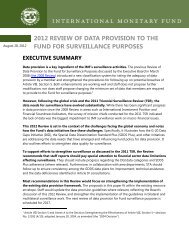ECB Annual Report on supervisory activities
ssmar2016.en.pdf?utm_source=POLITICO.EU&utm_campaign=b1bb431652-EMAIL_CAMPAIGN_2017_03_23&utm_medium=email&utm_term=0_10959edeb5-b1bb431652-189797857&utm_source=POLITICO
ssmar2016.en.pdf?utm_source=POLITICO.EU&utm_campaign=b1bb431652-EMAIL_CAMPAIGN_2017_03_23&utm_medium=email&utm_term=0_10959edeb5-b1bb431652-189797857&utm_source=POLITICO
You also want an ePaper? Increase the reach of your titles
YUMPU automatically turns print PDFs into web optimized ePapers that Google loves.
Chart 2<br />
Stable level of return <strong>on</strong> equity in 2016 due to lower<br />
impairment charges offsetting the decline in operating<br />
profits<br />
(All items are weighted averages displayed as a percentage of equity)<br />
15%<br />
10%<br />
5%<br />
0%<br />
-5%<br />
-10%<br />
Pre-impairment operating profits<br />
Impairments<br />
Other<br />
Return <strong>on</strong> equity<br />
2015 2016<br />
The negative impact of decreasing revenues was partly<br />
mitigated by lower operating expenses (-1%). The cost<br />
reducti<strong>on</strong> was particularly pr<strong>on</strong>ounced for staff<br />
expenses (-1.4% year <strong>on</strong> year). In view of the<br />
restructuring measures recently undertaken by several<br />
euro area banks, the trend may c<strong>on</strong>tinue in the coming<br />
quarters.<br />
Improving macroec<strong>on</strong>omic c<strong>on</strong>diti<strong>on</strong>s had a positive<br />
effect <strong>on</strong> impairment charges, which were lower than in<br />
2015: impairments <strong>on</strong> loans and other financial assets<br />
dropped from 5.5% of aggregate equity in the third<br />
quarter of 2015 6 to 4.4% in the third quarter of 2016.<br />
Most of the improvement was c<strong>on</strong>centrated in a few<br />
jurisdicti<strong>on</strong>s, while credit losses had already been at<br />
historically low levels in some of the other countries.<br />
Past experience suggests that banks tend to book<br />
higher impairments in the fourth quarter, which could<br />
affect profitability results over the full year.<br />
Data for both years are shown as Q3 cumulated figures annualised.<br />
Source: FINREP framework (101 significant instituti<strong>on</strong>s reporting IFRS data at the<br />
highest level of c<strong>on</strong>solidati<strong>on</strong>).<br />
Extraordinary sources of income supported banks’<br />
profitability in 2016 (3.4% of aggregate equity in the<br />
third quarter of 2016). However, <strong>on</strong>e-off gains were lower than in 2015 and may not<br />
be repeated in the coming quarters.<br />
1.2 Implementing the SSM model of supervisi<strong>on</strong><br />
1.2.1 Refining the SSM SREP methodology<br />
Owing to improvements in the<br />
SREP methodology, the correlati<strong>on</strong><br />
of banks’ risk profiles with their<br />
capital requirements increased<br />
76%<br />
Correlati<strong>on</strong> between<br />
capital requirements and<br />
risk profiles<br />
Based <strong>on</strong> a comm<strong>on</strong> methodology for the largest banking groups in the euro area,<br />
European banking supervisi<strong>on</strong> carried out the SREP for the sec<strong>on</strong>d time in 2016.<br />
Again, the objective was to promote a resilient banking system that is able to<br />
sustainably finance the euro area ec<strong>on</strong>omy. The harm<strong>on</strong>isati<strong>on</strong> already achieved in<br />
the 2015 <strong>supervisory</strong> cycle led to tangible results in this regard. Building <strong>on</strong> these<br />
achievements, the SREP assessment has been enhanced. The enhancements are<br />
reflected in an increased correlati<strong>on</strong> of capital requirements with banks’ risk profiles<br />
(from 68% after the SREP 2015 to 76% after the SREP 2016). At the same time, the<br />
general approach of combining quantitative and qualitative elements through<br />
c<strong>on</strong>strained expert judgement has been maintained. In additi<strong>on</strong>, the SREP<br />
methodology has been further complemented in order to incorporate the results of<br />
the 2016 EU-wide stress test.<br />
6<br />
The figure for the fourth quarter of 2015 was 5.8%.<br />
<str<strong>on</strong>g>ECB</str<strong>on</strong>g> <str<strong>on</strong>g>Annual</str<strong>on</strong>g> <str<strong>on</strong>g>Report</str<strong>on</strong>g> <strong>on</strong> <strong>supervisory</strong> <strong>activities</strong> 2016 − Supervisory c<strong>on</strong>tributi<strong>on</strong> to financial<br />
stability 13



